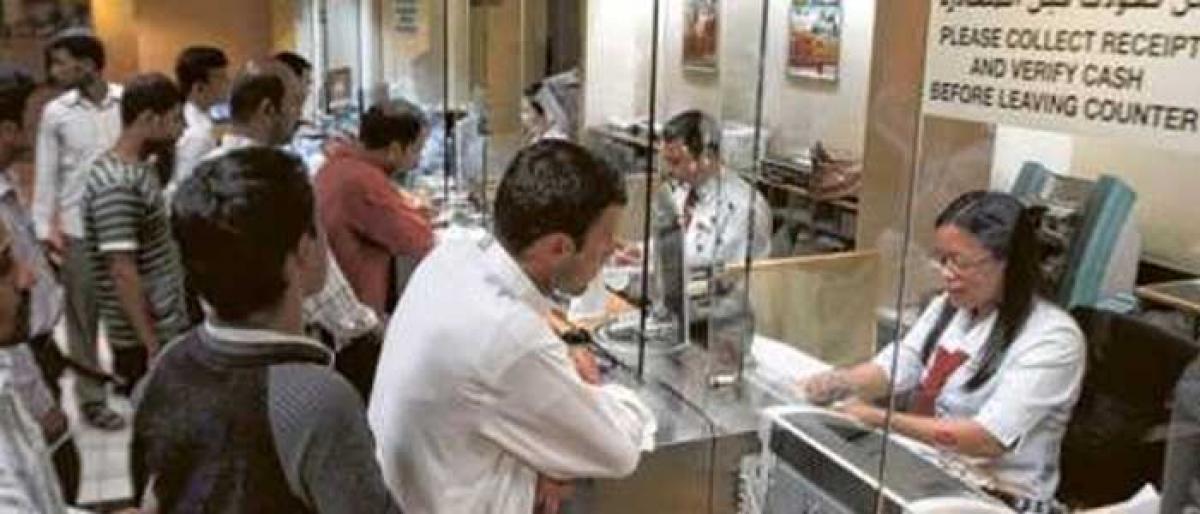Live
- First Impressions and Unboxing of the MacBook Pro M4: A Powerhouse for Professionals and Creators
- China Gears Up for Potential Trade War Amid Trump’s Tariff Threats
- Small Farmers Gain Less by Selling to Supermarkets: Study Reveals
- Why Despite the Controversy, America Is Anticipating the Mike Tyson vs. Jake Paul Fight
- Sanju Samson and Tilak Varma Shine: Record-Breaking Feats in 4th T20I Against South Africa
- India Urges $1.3 Trillion Annual Climate Support for Developing Nations
- Bad air: 106 shuttle buses, 60 extra Metro trips planned to make Delhiites give up cars
- WHO reports declining monkeypox cases in Congo
- CM Attends Kotideepotsavam on Kartika Purnima
- PKL Season 11: Raiding trio of Devank, Ayan, Sandeep help Patna Pirates rout Bengal Warriorz
Just In

Inward remittances to Telangana and Andhra Pradesh, which together occupy second slot after Kerala in NRI inflows, dropped by over 15 per cent this year so far thanks to a gamut of factors, including rising rupee, adverse conditions in the Gulf region, Trumponomics and demonetisation.
Hyderabad: Inward remittances to Telangana and Andhra Pradesh, which together occupy second slot after Kerala in NRI inflows, dropped by over 15 per cent this year so far thanks to a gamut of factors, including rising rupee, adverse conditions in the Gulf region, Trumponomics and demonetisation.
Though the decline in remittances at national level is about 10 per cent, it was steeper drop ranging between 15 per cent and 20 per cent for Telangana and Andhra Pradesh, said an official at a leading money exchange. NRIs from Telangana and AP have tightened the purse strings on outward remittances to homeland and prefer to keep surplus with them.
“I used to send 75 per cent of my earnings to my parents in Karimnagar. But, I cut this down drastically owing to appreciation of rupee. I am sending money just for their monthly expenses. I’ll wait for right time till I get a better exchange rate to send my savings,” says Bhim Reddy, who works as a manager at a mall in Dubai.
Inward remittances were already worst hit after demonetisation, which was announced on November 8, 2016. Almost over 50 per cent drop in remittances via money exchanges as NRIs prefer to make online money transfer directly into bank accounts of recipients. UAE, Qatar, Saudi Arabia, Kuwait and Oman contributed over 60 per cent of total remittances to Telangana.
“First it was note ban that hit us worst. Then rupee rise came as a jolt. Our income from remittances dropped by over 50 per cent this year so far.”
“We get over 60 per cent remittances from Gulf nations mostly from Dubai and Saudi Arabia and 22 per cent from the US and rest from UK, Canada, Australia, etc,” said the top official at the money exchange in the city.
According to the latest report of World Bank, the total global remittance flow in 2016 was $442 billion, of which India was the top nation to receive $62.7 bn. Of this, UAE remittances to India were $13 billion, according to Promoth Manghat, CEO, UAE Exchange Group, which has 53 branches in TS and AP, including 12 in Hyderabad alone.
Remittances are expected to fall further as the situation may get more worse as rupee, as per latest studies, may hit 60 against the dollar by the year-end. Rupee rose over six per cent this year and closed at 64.08 as against US dollar on Thursday.
“The appreciation in INR should comparatively reduce the remittance volume. But, the regular remitters will send money for family maintenance irrespective of currency fluctuations. It is the opportunist remitters, who wait for currency depreciation to take advantage of getting more money in conversion, while sending money to India,” Manghat told The Hans India.
“Meanwhile, it’s still a good time for NRIs to remit funds to NRE accounts as rupee is expected to range between 61 and 65 per dollar. Since the GCC is mostly USD denominated, the interest rate reduction in India or minor appreciation in INR value isn’t going to impact much to the fund transfers of an NRI, who will anyway enjoy an overall benefit. Also, capital markets are doing well in India. NRIs should take advantage of the same and look beyond NRE deposits to invest in the capital market,” adds Manghat.
According to the UN study said, while Indian topped the remittances charts in 2017 with $62.7 billion, China ($61 billion) stood second followed by the Philippines ($30 billion) and Pakistan ($20 billion). Despite retaining the top position in global remittances, India recorded 9.13 per cent drop from $69 bn remittances flown in 2015.
With one-third share, Kerala is undisputed leader in inward remittances followed by Punjab, Tamil Nadu, UP, Telangana and Andhra Pradesh. However, prior to Telangana state formation, united AP was at second position after Kerala, followed by Tamil Nadu, Punjab and UP.

© 2024 Hyderabad Media House Limited/The Hans India. All rights reserved. Powered by hocalwire.com







